Barcelona are a team in crisis. Yes, not many would say so considering their incredible trophy haul in the last decade or so but with each passing year, the Azulgranas are one step closer to collapse. Of course, this may or may not be an exaggeration since they are among the most marketable and famous clubs on the planet, not to mention that they are indeed a team that still houses the best player in the world and arguably, the history of football.
Still, the financial aspect and the glamour is often but a facade of a giant that is on his last legs. We’ve seen a similar thing happen to AC Milan in recent history and there are more falls from grace if we go further down the line. It’s difficult to imagine Barcelona follow in those very same footsteps – they are still very much La Liga‘s heavy hitters and one of the most recognisable names in sports in general.
The reality, however, is much grimmer than that. The figures state Barcelona have colossal debts to pay off, the recent outbreak has costed them around €154m if reports are to be believed and quite frankly, not many teams have fumbled their lines in the transfer market as much as the mighty Catalans have, potentially failing with three €100m+ signings in the last couple of years.
For that reason, this data analysis will use statistics to establish the first phase of a potential new recruitment strategy for Barcelona’s immediate future, including the review of the current squad, past transfer business and then finally, taking a look into the biggest visited markets to unearth potential reinforcements, all using data.
Let’s dive straight in.
Current squad & past transfer business
Before we start forming a new recruitment strategy for Barcelona, it’s important to take a look at how exactly have their past ventures moulded their current, 2019/20, squad. It’s only reasonable to take a look at all the players they have used throughout the campaign and create an age profile of the team.
Below, you can see the graph that will tell us which players are used the most. We have divided the squad into youth players (<24), players in their peak years (24-29) and experienced players (30+) and used their stats from 2019/20 to form the age matrix.
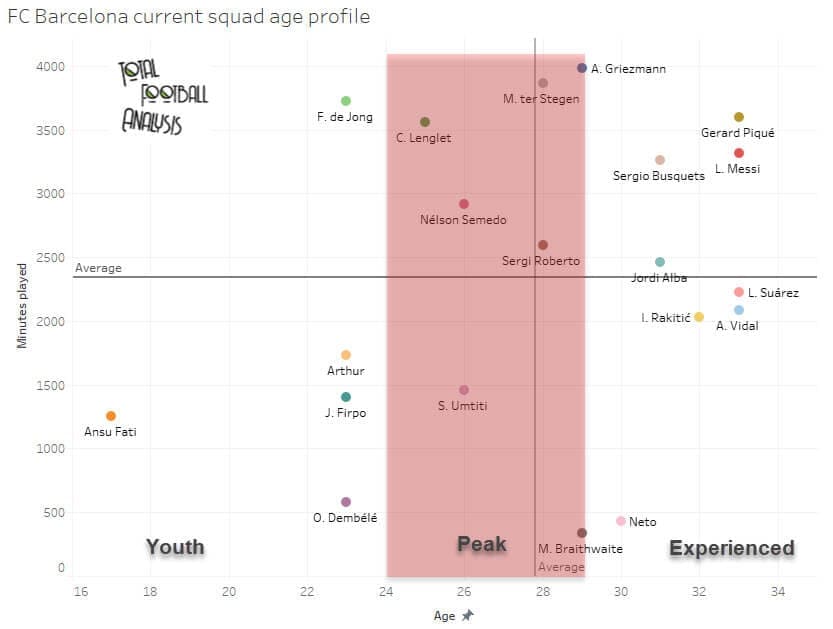
Unsurprisingly, Barcelona’s most important players are all in the peak and experienced categories with only one young player having a clear key role in the squad – Frenkie de Jong (23-years-old, 3 724 minutes played). Nélson Semedo is also there but he was in and out of the team and has even been rumoured to be on the club’s blacklist as well.
Antoine Griezmann, who is another key figure, at least according to game time, is exiting his prime and only Marc-André ter Stegen, Clement Lenglet and Sergi Roberto are still playing in their very peak at the moment. The most troubling aspect of this age chart, however, is the fact that Barcelona have seven players with a significant role over the age of 30 with Lionel Messi’s, Jordi Alba’s and Luis Suárez’s minute tallies also dipping a bit due to injuries. Ivan Rakitić and Arturo Vidal are still on the rise and will likely register more minutes until the end of the season – another worrying sign despite their obvious qualities.
By further analysing their squad, we can see their current market values compared to their market values before their debut for Barcelona and the total fee that was paid for them by the club.
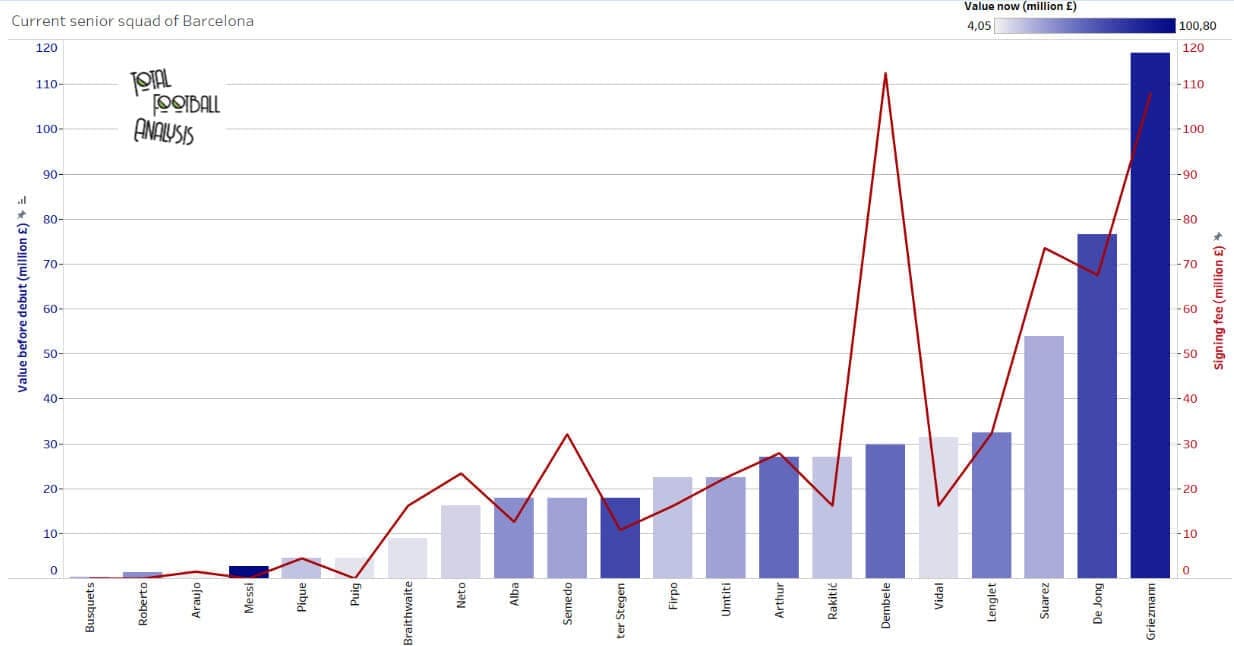
We can see that only the La Masia players like Messi, Busquets, Sergi Roberto and Piqué – who was brought back from Manchester United for a relatively small fee – are worth more than they used to be before debut and Barcelona have ‘paid’ less for them than what they are/ were actually worth. This is a clear sign that most of the rest of the team is in clear decline due to age, injuries or simply underperformance.
The biggest spike can be seen with Ousmane Dembélé who was signed for £112.5m with Barcelona incredibly overpaying and is now worth around £50.4m. Apart from La Masia graduates, players who are now worth more than their signing-on fee are Ter Stegen, Arthur Melo (who just departed to Juventus), Jordi Alba, Lenglet, Samuel Umtiti (who has declined massively and is now worth the same amount he was before his debut), Junior Firpo and Rakitić but with the latter two now worth less than they were before their debut.
Next are the current team tactics. Below, you can see a chart that Total Football Analysis uses to describe a team’s general style of play, both in the offensive and defensive phase, and we can see Barcelona’s right here.
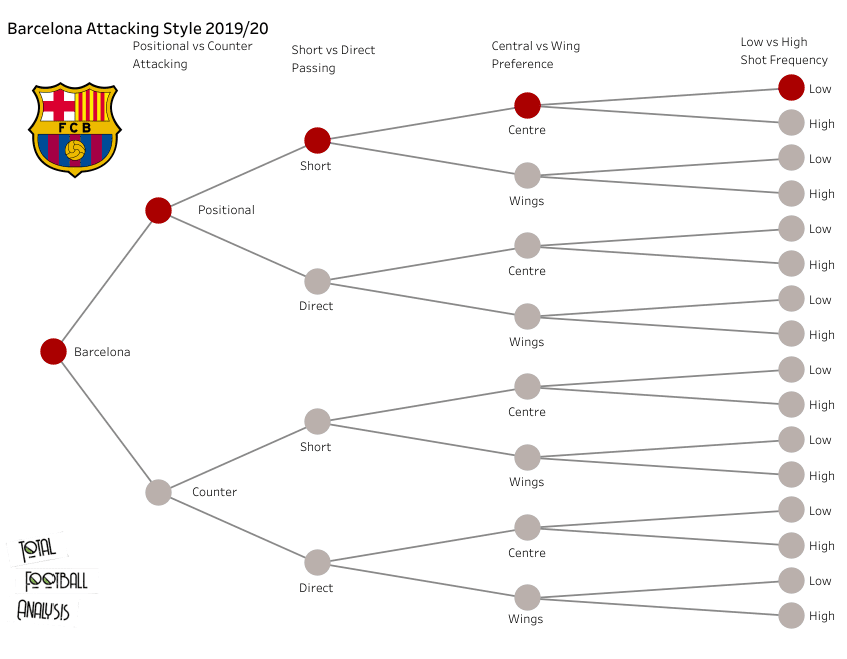
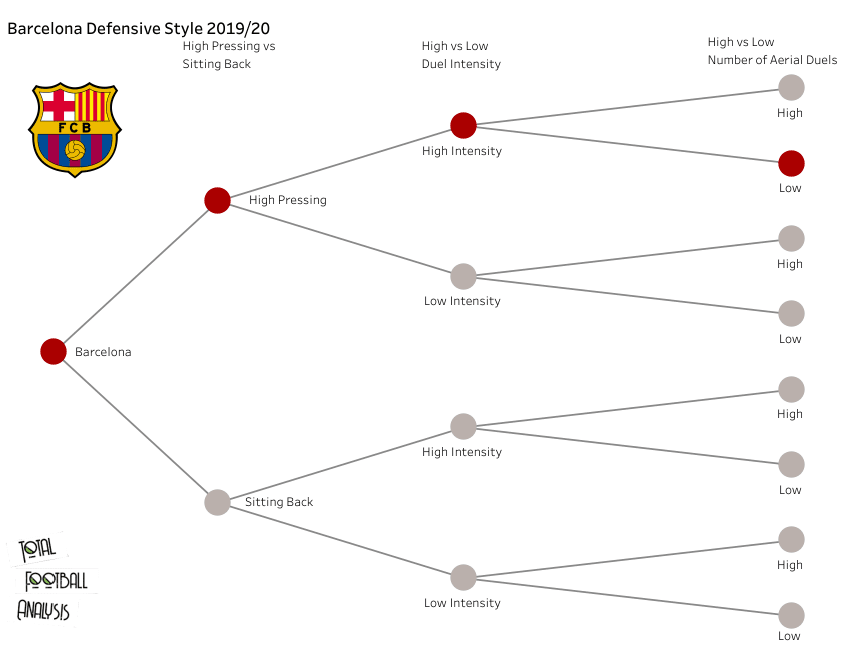
We can see that Barcelona prefer a positional approach, building their attacks through short passing, and will mostly advance through the centre of the pitch with a low shooting frequency. In defence, they press highly and with intensity, tallying a low number of aerial duels per game too.
Team style is essential when looking at potential recruits and, as we will see shortly, it’s something they might have disregarded when conducting their business in recent years. But speaking of the transfers they have done over the years, we have created a map that will show us which markets did Barcelona favour around the globe in the last decade.
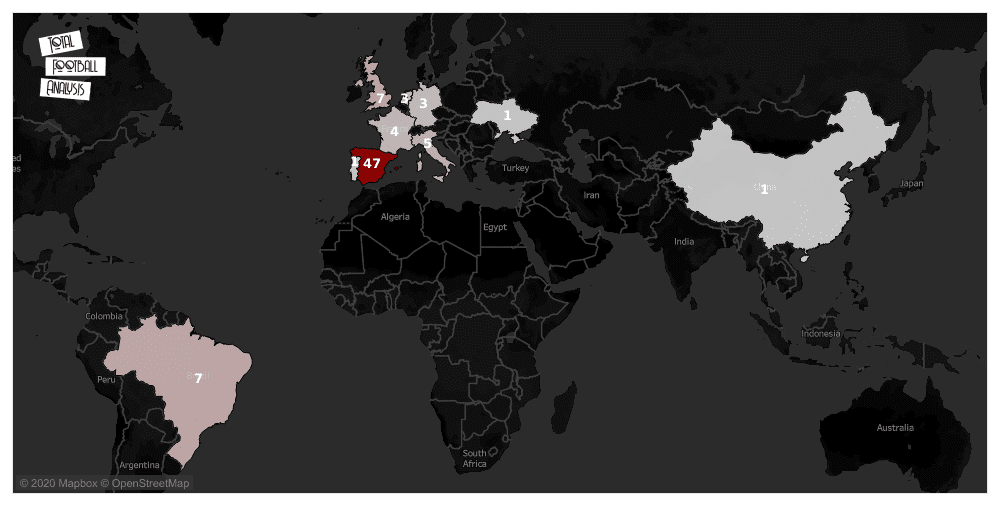
The map is mostly self-explanatory – it shows us the hotspots for Barcelona’s transfer business in the last 10 years and we can see a couple of most important markets: Spain (47), Brazil & England (7), Italy (5), France (4) and Germany (3). It’s also important to note that the influence of La Masia has also had a big impact on the map since the first team of Barcelona has recruited a big part of their squad from the youth teams.
That trend has somewhat slowed down in recent years too but Spain is still the most dominant market they look into when recruiting new players. Now that we know where they like to shop across the world, let’s see how successful their investments have been. During the days of Pep Guardiola and the golden generation of La Masia, Barcelona were surely not the spending types and instead prided themselves on creating superstars rather than buying them.
However, things have taken a hard turn ever since the departure of Neymar Júnior. For reference sake, we’ll take their transfer activity in the last four years into account to get a clearer picture of this drastic change in policy. The graph below shows us the three most successful teams across the top five leagues between 2016/17 and 2019/20 in terms of average points per game gained and their total net spend.
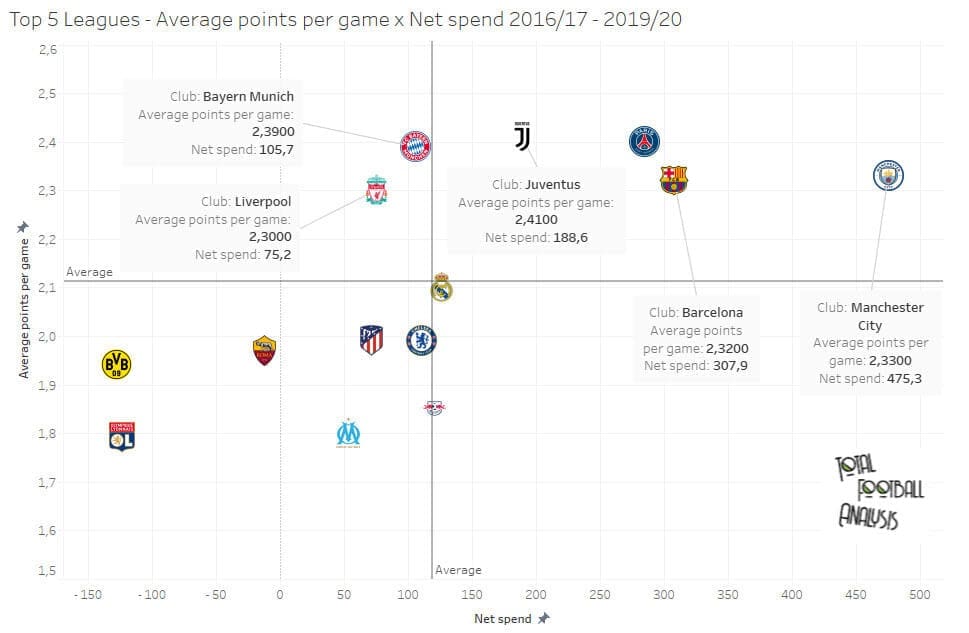
We can see that Barcelona have averaged 2.32 points per game in that four-season period but have also spent a grand total of £307.9m, only second to Manchester City’s 2.33 points and £475.3m net spending.
That figure for Barcelona is certainly over the top, especially when compared to the far superior transfer policies of Liverpool, Bayern Munich and Juventus, all of whom averaged at least 2.3 points per game in that period with significantly less money spent. The Germans and Italians have even managed to outperform Barcelona in their respective leagues in average points gathered while investing far less into their squad.
Another indicator of their failings in the market from 2016/17 onward can be seen in the graph down below. Here, we have outlined the number of signings per season, their average age and the number of players that are still at the club to this day. Needless to say, it makes for sour reading for Barcelona fans.
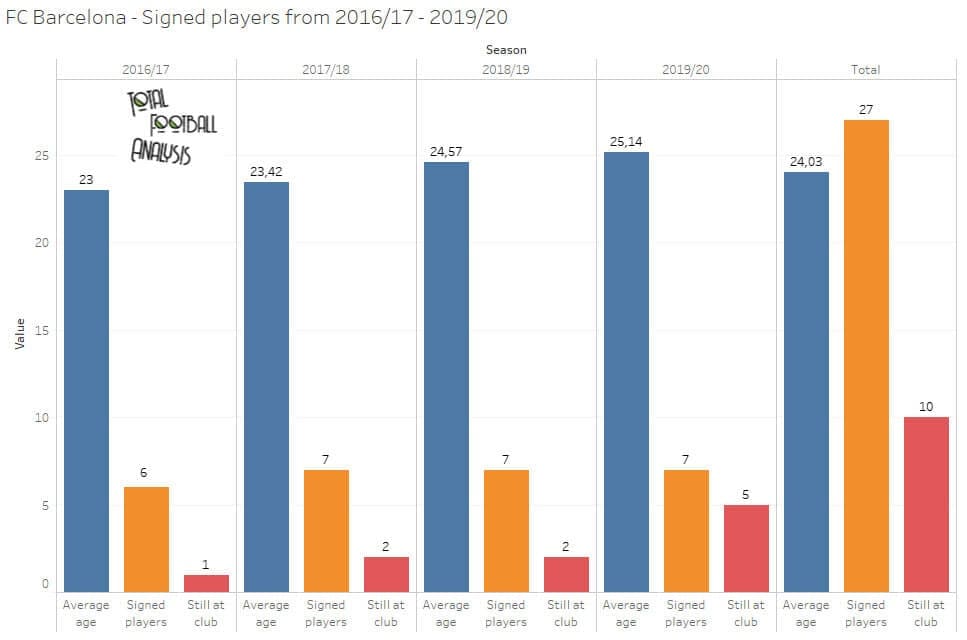
There are two things worth noticing in the graph. Firstly, notice how the average age of signed players has grown over the years from 23 in 2016/17 to 25.14 in 2019/20. The second and even more worrying thing is the number of players still at the club. Out of the 27 players that were bought in that period, only 10 are still at the club, with an added caveat that five of those were also signed in 2019/20. Quite shocking.
But how exactly have those transfers performed during their stay at Barcelona over the years and have any warranted their price tags in the first place?
Analysing Barcelona’s signings (2016/17 – 2019/20)
For this part of the analysis, we have decided to take 15 players Barcelona signed in those four years – who have also managed to accumulate enough game time – and analyse them in the four key metrics: attack, defence, progression and creativity. Each player’s stats were taken for the time they spent at the club and of course, their minute tally varies but we’ve taken their per 90 figures to even the playing field out a bit.
For starters, we’ll take a look at the defensive output, which can be seen in the graph below. Note that the graph shows ‘defensive output’ – a metric we have created by combining the players’ possession-adjusted (PAdj) tackles and PAdj interceptions per 90 minutes for the time they spent at Barcelona.
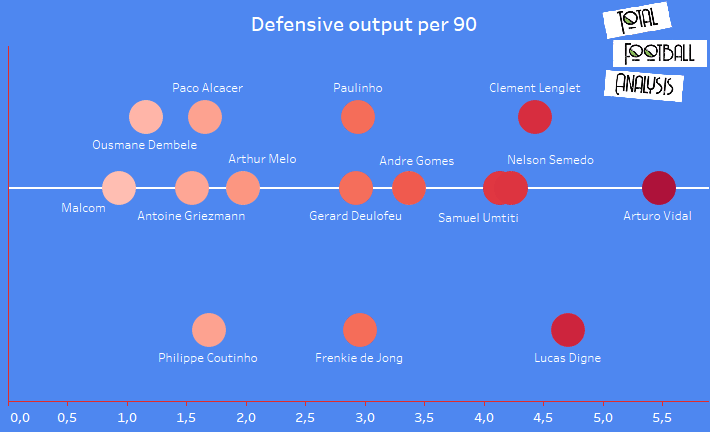
Interestingly enough, Vidal, who is among the transfers who are seemingly paying off their low price tag, leads the way with 5.47 defensive actions per 90 minutes. The Chilean is then closely followed by Lucas Digne with 4.71 and Lenglet with 4.43 as the two Frenchmen seemed to have a great impact on their defence with the latter now becoming a key part of their backline.
Digne never found his footing in Catalonia but is now enjoying his stay in the Premier League, confirming that there indeed was quality in him. Next, we will take a look at the rate at which the players helped progress the ball higher up the pitch. To get this metric, which we can call ‘progressive actions’, we combined their progressive passes per 90 minutes and progressive distance covered with the ball per 90 minutes.
Another thing to note here is that we have excluded the passes that were sent from the defending 40% of the pitch.
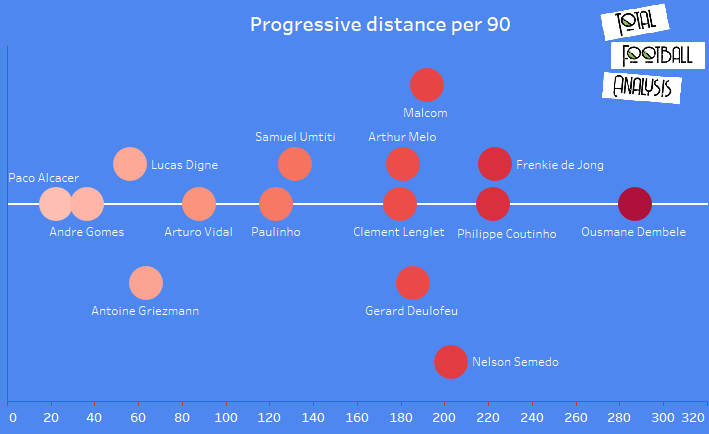
Perhaps surprisingly, Dembélé is the player leading the line in this metric with 287.08 progressive actions per 90 minutes as the Frenchman has a knack of carrying the ball during his marauding runs. Of course, the low game time has to be taken into account here which has undoubtedly inflated the results a bit.
The winger is then followed by De Jong who sits on 223.24 and is excelling in this particular category. Even more so considering that he’s been a regular part of the team until his recent injury. Finally, we have Philippe Coutinho, who’s still on loan at Bayern but will almost surely be leaving permanently soon. He is in third place with 222.26 progressive actions per 90 minutes.
The third metric we’ll be looking at is creativity – a metric we got by combining the players’ passes into the penalty area per 90 minutes and key passes per 90 minutes.
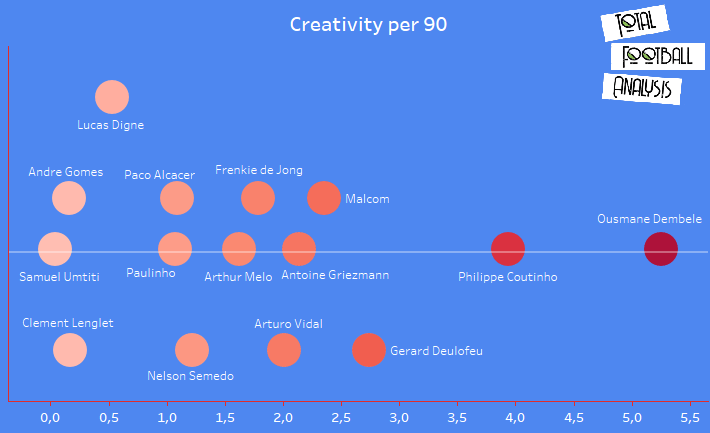
Once again, the most creative player out of all those transfers is Dembélé as he has tallied a score of 5.25 in this metric. This is an indicator that the winger would indeed be an incredible asset were it not for his constant injuries and fitness problems.
He is closely followed by Coutinho with 3.94 and then by Gerard Deulofeu with 2.74. Both, however, are not at Barcelona anymore and are also unlikely to return. This leaves us with the final metric we’ll be analysing – expected goal contribution per 90 minutes.
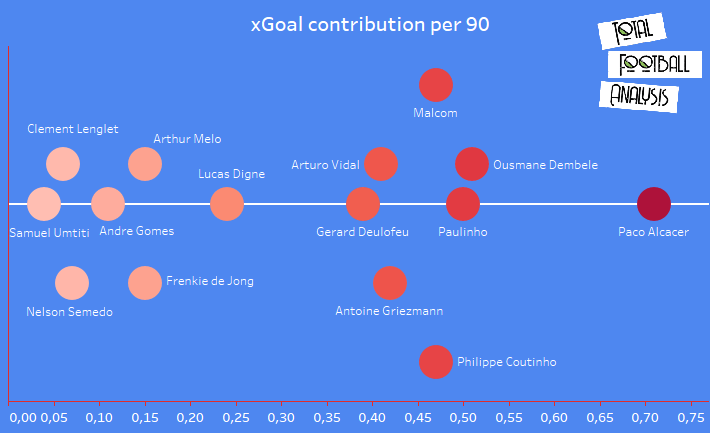
Expected goal contribution is a metric we got by combining the players’ expected goals (xG) per 90 minutes with their expected assists (xA) per 90 minutes. And this time, we have a new name at the very top – Paco Alcácer. The current Villarreal striker has amassed a total of 0.71 xGoal contribution per 90 during his stay at Barcelona.
After him, we have Dembélé on 0.51 and both Malcom and Coutinho on 0.47.
Creating a new recruitment strategy
This is essentially where things get tricky but fun. The next step in our data analysis will be to start creating a new recruitment strategy for Barcelona. This includes identifying the key markets for them to access, set the required metrics and finally, scout for talents and players that can improve the squad.
Seeing how Barcelona prefer to bring in players from Spain and from within, we will use both La Liga and Barcelona B as one key market and will add the remainder of the top five leagues and the Brazilian Serie A, seeing as that is also one of the main markets the Catalans often access.
It’s also important to note that we’re looking for young players between the age of 20-26 who have played more than 1000 minutes in 2019/20 for their respective clubs and will once again be looking for four key metrics: defensive output, progression, creativity and attacking ability. Seeing how Barcelona can’t afford to splash the cash, we have also set the filter to €70m market value so we can focus on some of the potentially cheaper assets.
And since we’re dealing with a high number of players, we have divided them into defenders, midfielders and attackers to ease the load and make the reading of the data clearer and smoother. We’ll start by looking at the defenders by measuring their successful defensive actions per 90 minutes and possession-adjusted interceptions per 90 minutes. Note, however, that we are only taking the defenders who are also good on the ball by highlighting the ones who progress the play through a combination of progressive runs and passes.
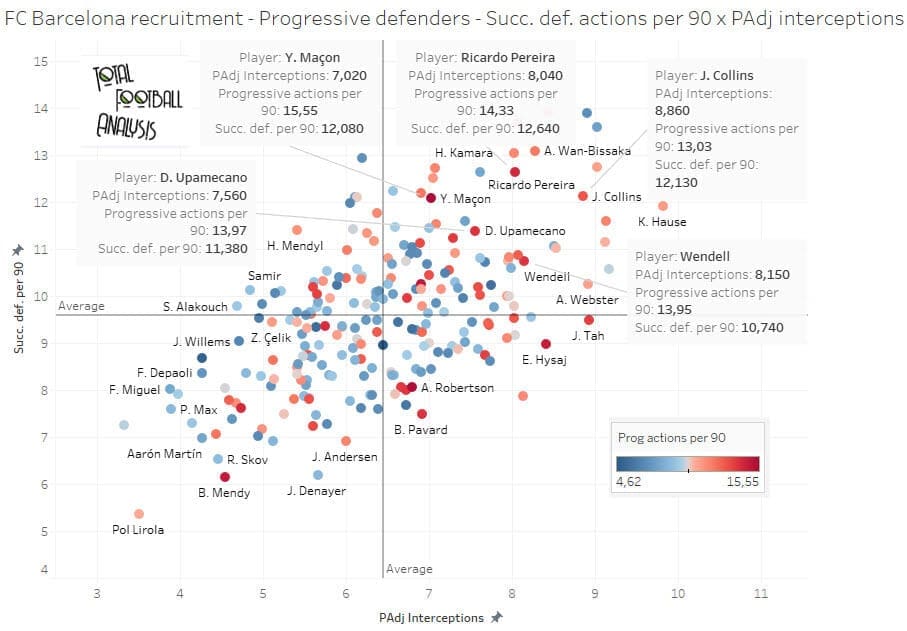
If a player is appearing more red in the graph, it means he has registered impressive progressive statistics in 2019/20 and those are the players we are interested in along with the ones who are good at defending.
As you can see, we have highlighted several players who are impressive in both defending metrics and progressiveness, as indicated by the redness of their dots. Leicester City’s 26-year-old Ricardo Pereira is certainly among the best players here with 8.04 PAdj interceptions, 12.64 successful defensive actions but also with 14.33 progressive actions per 90 minutes.
Another really interesting prospect is Yvann Maçon, the 21-year-old full-back from Saint-Etienne who tallied 7.02 PAdj interceptions, 12.08 successful defensive actions and highly impressive 15.55 progressive actions per 90 minutes. Apart from him, there is also Jamilu Collins, the 25-year-old left-back from Paderborn, Bayer Leverkusen’s Wendell and of course, Dayot Upamecano from RB Leipzig.
Next, we’ll identify some of the best progressors from the midfield and forward lines with the same filters applied. Interestingly enough, Barcelona already have one of the best young progressors in the world in Riqui Puig who has tallied 8.99 progressive passes and 5.64 progressive runs per 90 minutes.
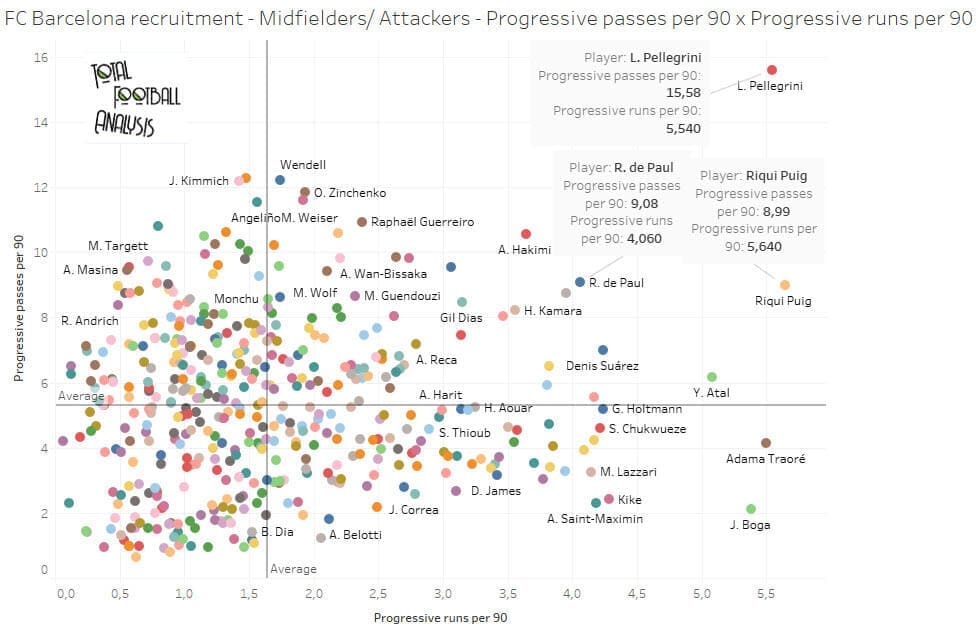
But there are a couple more really interesting names here with Udinese’s 26-year-old Rodrigo De Paul (9.08 and 4.06) and Roma’s Lorenzo Pellegrini (15.58 and 5.54). Of course, they are not the only ones as we can see other impressive players making an appearance with Wendell being present once again, this time alongside Joshua Kimmich, Raphaël Guerrero and Adama Traoré.
Next, we will still stay with midfielders and forwards but will now look at their deep completions and key passes per 90 minutes to see how creative they are in the final third of the pitch.
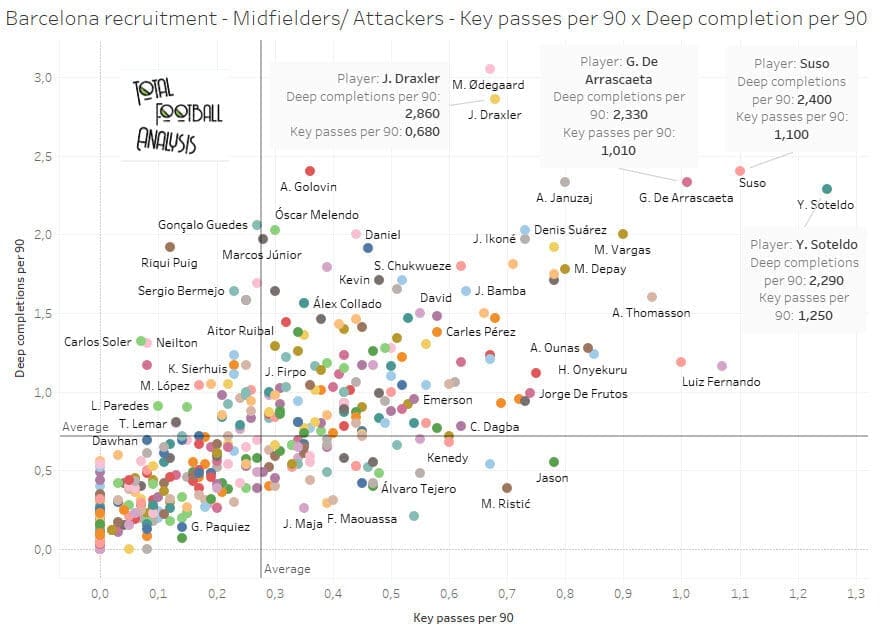
A couple of names really stand out from the crowd, first of which is Yeferson Soteldo from Santos with his 2.29 deep completions and 1.25 key passes per 90 minutes. He is closely followed by Suso (2.4 and 1.1) and Giorgian De Arrascaeta from Flamengo with 2.3 and 1.01 respectively.
Julian Draxler is also someone who shouldn’t be overlooked as he tallied 2.86 deep completions but only 0.68 key passes per 90 minutes. Alongside him, Martin Ødegaard, who’s now well out of reach for Barcelona, Matías Vargas from city rivals Espanyol and Adnan Januzaj also stand out.
Finally, we’ll look at lethality in front of goal by measuring expected goals and expected assists. Interestingly, De Arrascaeta seems to be a creative machine with 0.29 xA and 0.23 xG per 90 minutes.
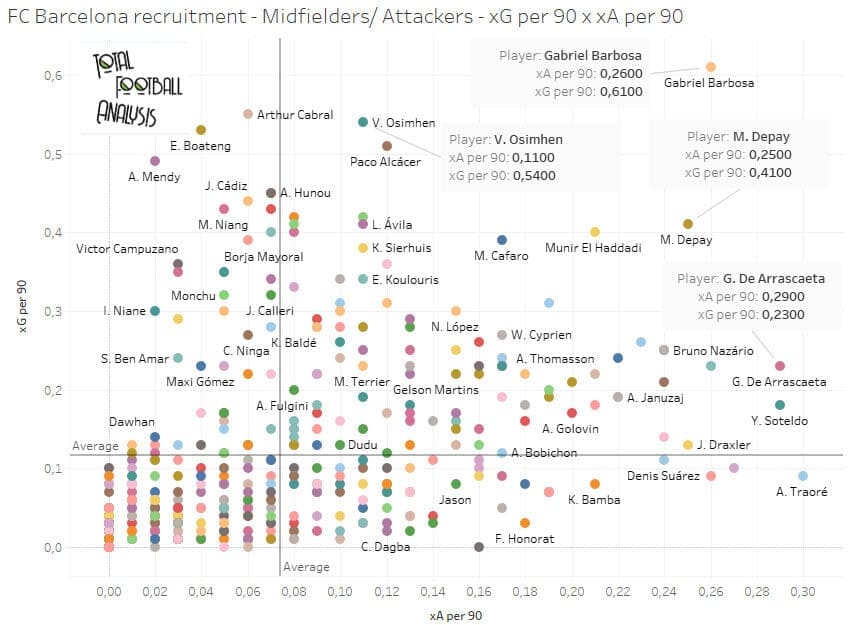
Memphis Depay is highly rated here with 0.25 and 0.41 respectively while Gabriel Barbosa is ahead of the pack with his incredible 0.26 xA and 0.61 xG per 90 minutes. We have also highlighted Victor Osimhen for his impressive 0.54 xG tally. There are, of course, more of them such as Chimy Ávila, Munir or Yannick Carrasco.
Final remarks
It has to be noted that this data analysis serves only as the first step in creating a completely new recruitment plan for Barcelona. We have gone through their transfer history, analysed their past purchases and have set the criteria for future acquisitions while also highlighting some of the best young prospects across the globe.
The next step would be to create a shortlist, narrowing down the candidates according to suitability to the system and of course, availability on the market. Stay tuned as we continue this search in future analyses.

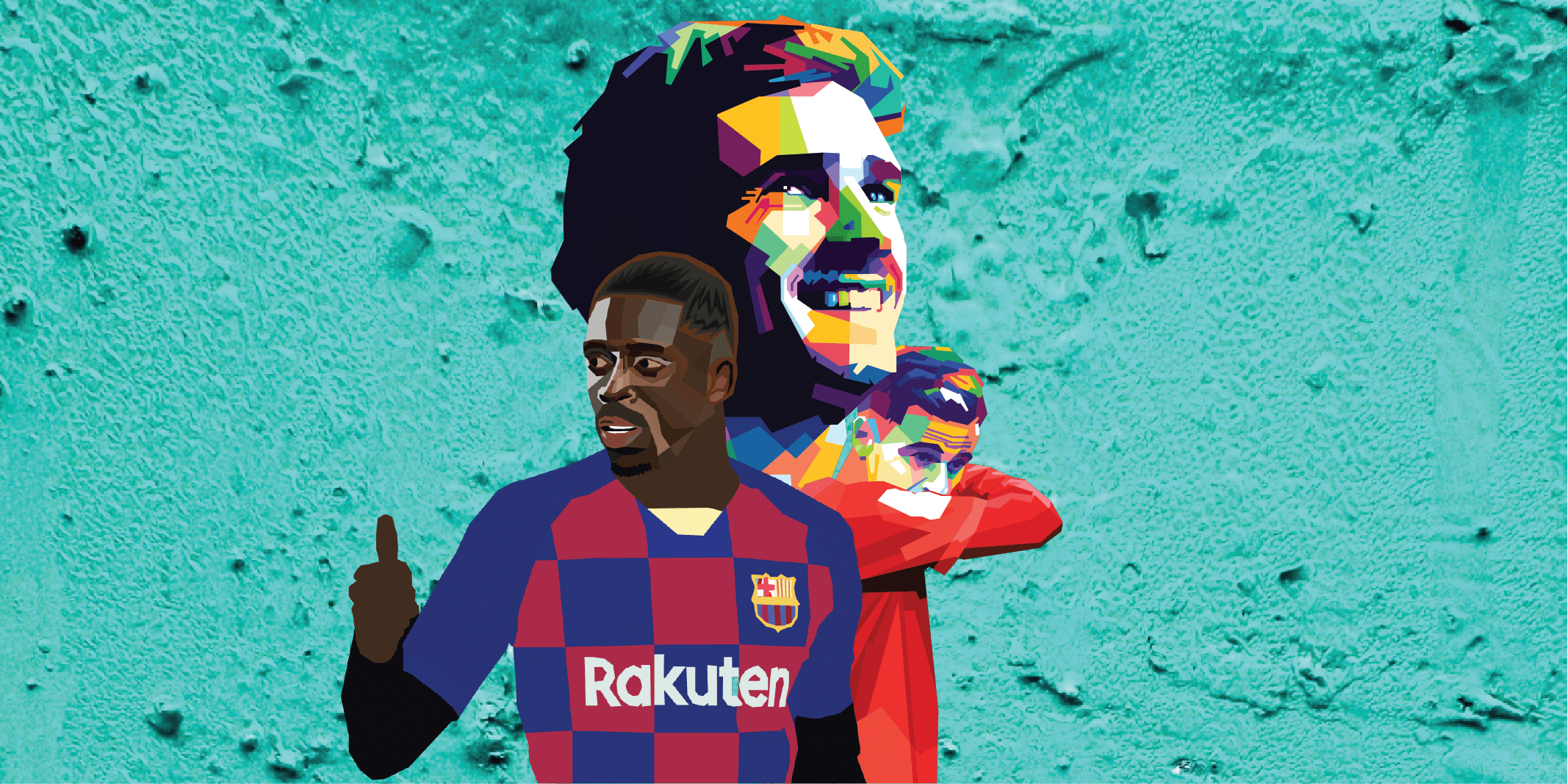




Comments